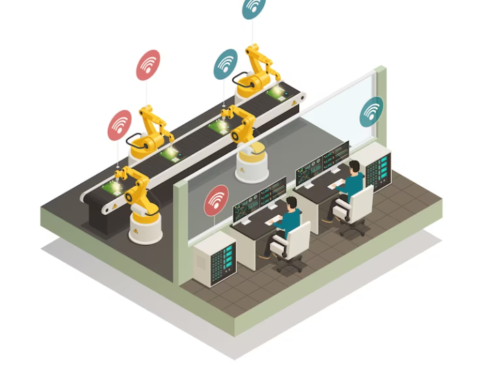In the ever-evolving developing scene of industry and assembling, the idea of accuracy has taken on another aspect through the appearance of modern robotization. This groundbreaking innovation has reformed how items are made as well as introduced a period of expanded effectiveness, exactness, and advancement. In this article, we will dive into the domain of industrial automation, exploring its components, benefits, limitations, and promising future, including its integration with robotics.
Introduction
Industrial automation, at its centre, includes the utilization of trend-setting innovations to smooth out and streamline modern cycles. It incorporates the arrangement of control frameworks, PCs, and data advances to deal with various undertakings with negligible human intervention. The essential goal is to upgrade efficiency, dependability, and by and large quality while reducing functional or operational expenses and human mistakes or errors.
Components
The parts of industrial automation work pair to consistently coordinate complex tasks. These parts incorporate sensors, actuators, programmable rationale regulators (PLCs), human-machine interfaces (HMIs), and communication networks. Sensors gather continuous information, which is handled by PLCs to settle on informed decisions. Actuators then execute commands, while HMIs give a user-friendly point of interaction for monitoring and control.
What is an Industrial Automation and Control System?
An industrial automation and control system refers to the coordination of different control gadgets, programming, and communication networks to direct and manage industrial processes. It includes administrative control, information security, and the execution of criticism circles to maintain the desired outcome. This system ensures that tasks run as expected, deviations are identified and corrected promptly, and overall, proficiency is maximized.
Technology Behind It
It innovation is embroidery woven from various mechanical strings or technical threads. This incorporates advanced mechanics, AI, algorithms, and the Web of Things (IoT). Robots outfitted with advanced sensors and AI algorithms or computer-based intelligence calculations, can perform undertakings with outrageous accuracy and consistency. Machine learning investigates vast datasets to streamline processes, while IoT gadgets empower constant observation and control.
Benefits and Limitations
The advantages of industrial automation are complex. It leads to elevated efficiency, as machines work enthusiastically without the requirement for breaks or moves. Automation minimizes errors, reduces waste, and upgrades item quality, in this way expanding consumer loyalty. Besides, it further develops work environment security by designating unsafe assignments to robots and decreasing human exposure to risk.
Be that as it may, industrial automation likewise presents specific limitations. Initial setup cost expenses can be significant, including interests in innovation or technology, preparation, and foundation. Moreover, the dependence on mechanization might prompt work relocation in certain areas, raising worries about joblessness. Finding some kind of harmony between human work and automation is vital to outfit the innovation’s maximum capacity.
Future Prospect
The eventual fate of Industrial Automation holds energizing prospects. As innovation keeps on propelling, automation systems will turn out to be much more modern and clever. AI will empower the system to adjust and improve processes continuously, answering evolving conditions. Cooperative robots, or cobots, will work close to human operators, upgrading efficiency and empowering more secure and effective operations.
Industrial Automation and Control: A Symbiotic Relationship
Industrial automation and control remain forever inseparable. Control systems give the knowledge and decision-making capabilities that drive automation. Through exact guidelines, control systems guarantee that robotization processes line up with predefined boundaries. This collaboration ensures that Industrial Automation works inside indicated limits, augmenting effectiveness, and dependability.
Industrial Automation and Robotics
The combination of industrial automation with robotics has opened new vistas of advancement. Modern robots, furnished with cutting-edge sensors and simulated intelligence, perform perplexing errands with immaculate accuracy. These robots can deal with redundant and difficult exercises, opening up human labourers to take part in additional creative and strategic roles. The cooperation between automation and robotics streamlines efficiency as well as lays the preparation for new domains of investigation or exploration in artificial intelligence.
CONCLUSION
All in all, the universe of industrial automation has introduced another period of accuracy, changing industry, and manufacturing processes. By utilizing state-of-the-art innovations, industrial automation improves effectiveness, quality, and security. While there are difficulties to explore, the advantages far offset the restrictions. As we look toward the future, the combination of robotics and automation vows to reshape ventures, raise human potential, and uncover remarkable skylines of development. The journey into this universe of accuracy proceeds, and the conceivable outcomes are boundless.
FAQ
What is industrial automation, and how does it work?
Ans- It includes utilizing cutting-edge innovations and control frameworks to perform errands in ventures without critical human intervention. It incorporates a scope of parts like sensors, PLCs, HMIs, and communications networks that cooperate to gather information, decide, and execute activities to optimize processes.
What are the key benefits of implementing industrial automation?
Ans- It offers a few advantages, including expanded efficiency, upgraded item quality, diminished functional expenses, further developed work environment security, and limited human blunders. It likewise empowers constant activity without breaks, leading to greater proficiency.
What types of industries can benefit from industrial automation?
Ans- This has applications across different industries, including manufacturing, auto, aviation, drugs, food and refreshment, and coordinated factors. Any area that includes dull errands, complex activities, or requires accuracy and precision can profit from automation.

